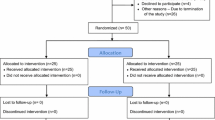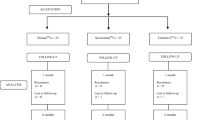Abstract
Background
Mesh fixation during laparoscopic ventral hernia repair can be performed using transfascial sutures or metal tacks. The aim of the present study is to compare mesh shrinkage and pain between two different techniques of mesh fixation in a prospective randomized trial.
Methods
A randomized trial was performed. Patients with ventral hernia of maximal diameter 8 cm were assigned to mesh fixation using either transfascial nonabsorbable sutures or metal tacks for fixation of a parietene composite mesh. The borders of the mesh were marked using clips, and radiological images in prone position were used for assessment of mesh size and location. The primary endpoint was mesh shrinkage; secondary endpoints included postoperative pain, mesh dislocation, and surgical morbidity.
Results
Demographic parameters were similar in both groups. A total of 40 patients were randomized, and 36 patients were available for follow-up. There was one hernia recurrence in each group. Pain was significantly higher following suture fixation after 6 weeks, but no difference was found after 6 months. Mesh shrinkage after 6 months was significantly higher using tacks for mesh fixation.
Conclusions
Transfascial sutures are associated with more pain within the first 6 postoperative weeks and less mesh shrinkage after 6 months compared with mesh fixation using metal tacks.



Similar content being viewed by others
References
Beldi G, Ipaktchi R, Wagner M, Gloor B, Candinas D (2006) Laparoscopic ventral hernia repair is safe and cost effective. Surg Endosc 20:92–95
Bingener J, Buck L, Richards M, Michalek J, Schwesinger W, Sirinek K (2007) Long-term outcomes in laparoscopic vs open ventral hernia repair. Arch Surg 142:562–567
Chelala E, Thoma M, Tatete B, Lemye AC, Dessily M, Alle JL (2007) The suturing concept for laparoscopic mesh fixation in ventral and incisional hernia repair: mid-term analysis of 400 cases. Surg Endosc 21:391–395
Heniford BT, Park A, Ramshaw BJ, Voeller G (2003) Laparoscopic repair of ventral hernias: nine years’ experience with 850 consecutive hernias. Ann Surg 238:391–399; discussion 399–400
Olmi S, Scaini A, Cesana GC, Erba L, Croce E (2007) Laparoscopic versus open incisional hernia repair: an open randomized controlled study. Surg Endosc 21:555–559
Kapischke M, Schulz T, Schipper T, Tensfeldt J, Caliebe A (2008) Open versus laparoscopic incisional hernia repair: something different from a meta-analysis. Surg Endosc 22:2251–2260
Asencio F, Aguilo J, Peiro S, Carbo J, Ferri R, Caro F, Ahmad M (2009) Open randomized clinical trial of laparoscopic versus open incisional hernia repair. Surg Endosc 23:1441–1448
Sajid MS, Bokhari SA, Mallick AS, Cheek E, Baig MK (2009) Laparoscopic versus open repair of incisional/ventral hernia: a meta-analysis. Am J Surg 197:64–72
Wassenaar E, Schoenmaeckers E, Raymakers J, van der Palen J, Rakic S (2010) Mesh-fixation method and pain and quality of life after laparoscopic ventral or incisional hernia repair: a randomized trial of three fixation techniques. Surg Endosc 24:1296–1302
Carbonell AM, Matthews BD, Kercher KW, Heniford BT (2003) Technique for introducing large composite mesh while performing laparoscopic incisional hernioplasty. Surg Endosc 17:1506; author reply 1507
van’t Riet M, de Vos van Steenwijk PJ, Kleinrensink GJ, Steyerberg EW, Bonjer HJ (2002) Tensile strength of mesh fixation methods in laparoscopic incisional hernia repair. Surg Endosc 16:1713–1716
Winslow ER, Diaz S, Desai K, Meininger T, Soper NJ, Klingensmith ME (2004) Laparoscopic incisional hernia repair in a porcine model: what do transfixion sutures add? Surg Endosc 18:529–35
Karakousis CP, Volpe C, Tanski J, Colby ED, Winston J, Driscoll DL (1995) Use of a mesh for musculoaponeurotic defects of the abdominal wall in cancer surgery and the risk of bowel fistulas. J Am Coll Surg 181:11–16
Kaufman Z, Engelberg M, Zager M (1981) Fecal fistula: a late complication of Marlex mesh repair. Dis Colon Rectum 24:543–544
Begg C, Cho M, Eastwood S, Horton R, Moher D, Olkin I, Pitkin R, Rennie D, Schulz KF, Simel D, Stroup DF (1996) Improving the quality of reporting of randomized controlled trials. The CONSORT statement. JAMA 276:637–639
McGinty JJ, Hogle NJ, McCarthy H, Fowler DL (2005) A comparative study of adhesion formation and abdominal wall ingrowth after laparoscopic ventral hernia repair in a porcine model using multiple types of mesh. Surg Endosc 19:786–790
Jacob BP, Hogle NJ, Durak E, Kim T, Fowler DL (2007) Tissue ingrowth and bowel adhesion formation in an animal comparative study: polypropylene versus proceed versus parietex composite. Surg Endosc 21:629–633
Sickle KR, Baghai M, Mattar SG, Bowers SP, Ramaswamy A, Swafford V, Smith CD, Ramshaw BJ (2005) What happens to the rectus abdominus fascia after laparoscopic ventral hernia repair? Hernia 9:358–362
Hollinsky C, Kolbe T, Walter I, Joachim A, Sandberg S, Koch T, Rülicke T, Tuchmann A (2010) Tensile strength and adhesion formation of mesh fixation systems used in laparoscopic incisional hernia repair. Surg Endosc 24:1318–1324
Schoenmaeckers EJ, van der Valk SB, van den Hout HW, Raymakers JF, Rakic S (2009) Computed tomographic measurements of mesh shrinkage after laparoscopic ventral incisional hernia repair with an expanded polytetrafluoroethylene mesh. Surg Endosc 23:1620–1623
Acknowledgements
The study was funded by Sofradim/Covidien. We thank Brigitte Wanner for meticulous data collection, control of data, and analysis of radiographs.
Disclosures
Authors Guido Beldi, Markus Wagner, Lukas E. Bruegger, Anita Kurmann, and Daniel Candinas have no conflicts of interest or financial ties to disclose.
Author information
Authors and Affiliations
Corresponding author
Additional information
Guido Beldi and Markus Wagner contributed equally to this work.
Rights and permissions
About this article
Cite this article
Beldi, G., Wagner, M., Bruegger, L.E. et al. Mesh shrinkage and pain in laparoscopic ventral hernia repair: a randomized clinical trial comparing suture versus tack mesh fixation. Surg Endosc 25, 749–755 (2011). https://doi.org/10.1007/s00464-010-1246-0
Received:
Accepted:
Published:
Issue Date:
DOI: https://doi.org/10.1007/s00464-010-1246-0




